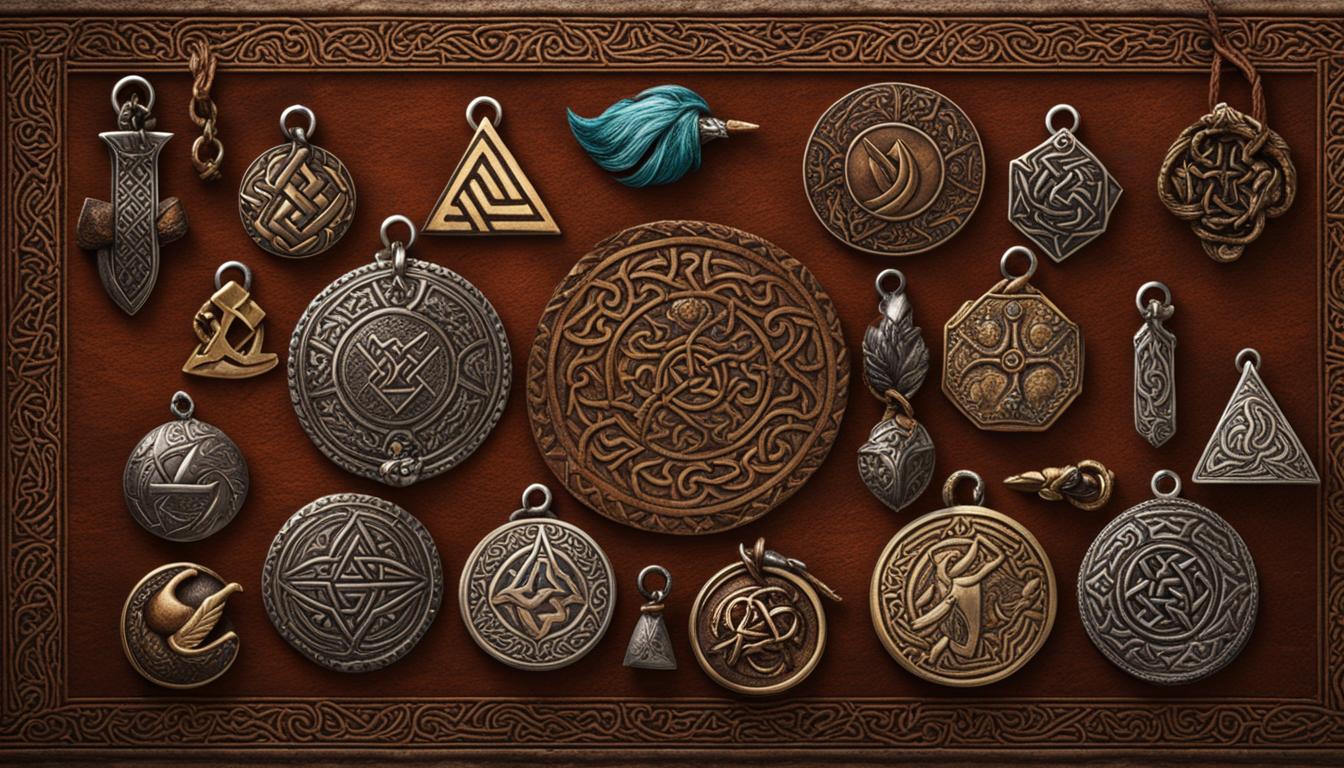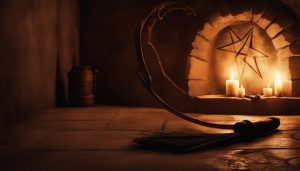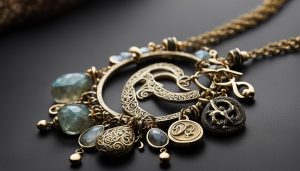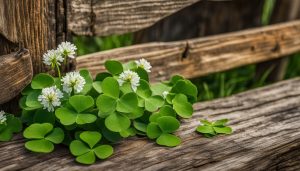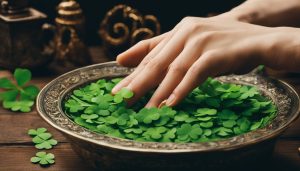Welcome to our exploration of Viking culture and superstitions. In this article, we will delve into the intriguing question: Did Vikings believe in good luck charms? Let’s uncover the truth behind the myths and unravel the fascinating beliefs of these legendary seafarers.
Vikings were renowned for their navigational skills and their extensive travels during the medieval period. While the existence of specific symbols like the Vegsvísir as a Viking compass is a subject of debate, there is evidence that Viking societies believed in the power of magic and symbolism.
Runes, skaldic poetry, and amulets adorned with carved symbols were common in Viking culture, indicating a strong belief in the magical properties of these objects. These beliefs played a vital role in shaping their worldview and guiding them throughout their journeys.
Contents
- 1 Norse Magic and Beliefs in Viking Societies
- 2 Viking Navigators: Sailing the Seas with Beliefs in Luck and Divine Guidance
- 3 The Controversy of the Viking Compass: Vegsvísir
- 4 The Concept of Luck in Norse Culture
- 5 Odin’s Symbols and their Meanings
- 6 The Significance of Viking Symbols in Norse Culture
- 7 Conclusion
- 8 FAQ
- 8.1 Did Vikings believe in good luck charms?
- 8.2 What was Norse magic and what role did it play in Viking societies?
- 8.3 How did Vikings navigate without modern tools?
- 8.4 What is the controversy surrounding the Viking compass, Vegsvísir?
- 8.5 How did Norse culture view luck?
- 8.6 What symbols are associated with Odin?
- 8.7 What was the significance of Viking symbols in Norse culture?
- 8.8 What is the conclusion about Viking symbols and beliefs?
- 9 Source Links
Key Takeaways:
- Viking culture embraced the power of magic and symbolism.
- Runes, skaldic poetry, and amulets were integral to Viking beliefs.
- Vikings placed great faith in the guidance and protection of the gods during their maritime journeys.
- The existence of specific symbols like the Vegsvísir as a Viking compass is still debated among historians.
- Luck was considered a personal quality in Norse culture, assigned by fate.
Norse Magic and Beliefs in Viking Societies
In Viking societies, belief in the supernatural was deeply ingrained in their culture and daily lives. Magic and symbolism played a significant role, intertwining with their beliefs and shaping their worldview. Norse magic, known as seiðr, was a mystical practice closely associated with soothsaying and divination, allowing individuals to glimpse into the future and influence their destinies.
The Vikings attributed magical qualities to various objects and symbols. Runes, ancient Norse alphabetic characters, were believed to possess mystical powers and were inscribed on objects such as weapons, jewelry, and amulets. Skaldic poetry, another important aspect of Viking culture, contained hidden meanings and invoked divine intervention.
Amulets with carved symbols were particularly prominent in Viking societies. These charms, often featuring elements like Thor’s hammer (Mjölnir) or the Valknut, were believed to provide protection, ward off evil spirits, and bring good fortune. The Vikings wore these amulets in battle, on their journeys, and in their daily lives, placing their trust in the supernatural powers associated with them.
“To the Viking, symbols were not just decorative elements; they held deep spiritual meanings and served as a conduit between the physical and spiritual realms.”
The use of symbols and magic in Viking societies demonstrated their belief in the existence of unseen forces that could be harnessed for personal gain or protection. It showcased their connection with the divine and their understanding of the supernatural world.
| Symbol | Meaning |
|---|---|
| Valknut | A symbol associated with Odin, representing his power and a connection to the afterlife. |
| Helm of Awe | A symbol of protection and courage, believed to grant strength and fearlessness in battle. |
| Thor’s Hammer (Mjölnir) | A symbol of Thor’s strength and power, used to invoke his protection and blessings. |
The Power of Symbols
- Viking symbols were not merely decorative but carried deep spiritual meanings.
- They served as a way to communicate with the divine and access supernatural powers.
- Each symbol had its unique significance, representing different gods, virtues, or aspects of the natural world.
- These symbols were used in rituals, ceremonies, and daily life to invoke divine guidance and protection.
The belief in magic, symbols, and the supernatural was an integral part of Viking societies. It shaped their actions, guided their decisions, and provided a sense of connection to the unseen forces of the world. The use of symbols and the practice of Norse magic demonstrated their belief in the power of the spiritual realm and their ability to influence their own destinies.
The Vikings were fearless navigators who ventured far and wide across treacherous seas, relying on their skill and knowledge to chart their course. Unlike modern sailors equipped with advanced tools, the Vikings had to rely on their instincts and the blessings of the gods to guide them safely on their maritime journeys. Belief in luck and divine protection played a significant role in their navigation practices, ensuring their confidence and determination throughout their expeditions.
When setting sail, Viking navigators sought the counsel of local witch/seeresses known as Völvas, who possessed the ability to commune with the gods and foresee the future. These wise women provided valuable insights and guidance, helping the Vikings make informed decisions about their routes and weather conditions. Additionally, the Vikings may have used magic symbols and made offerings to appease the gods and ensure favorable winds, calm waters, and safe passage.
The importance of luck in Viking navigation cannot be overstated. They believed that luck, or “hamingja,” was a personal quality granted by the gods and carried from one’s ancestors. A lucky individual was seen as favored by the gods, ensuring their protection and success in their maritime endeavors. This concept of luck as a personal attribute influenced the Vikings’ confidence and resilience, reinforcing their belief in their ability to overcome challenges and reach their destinations.
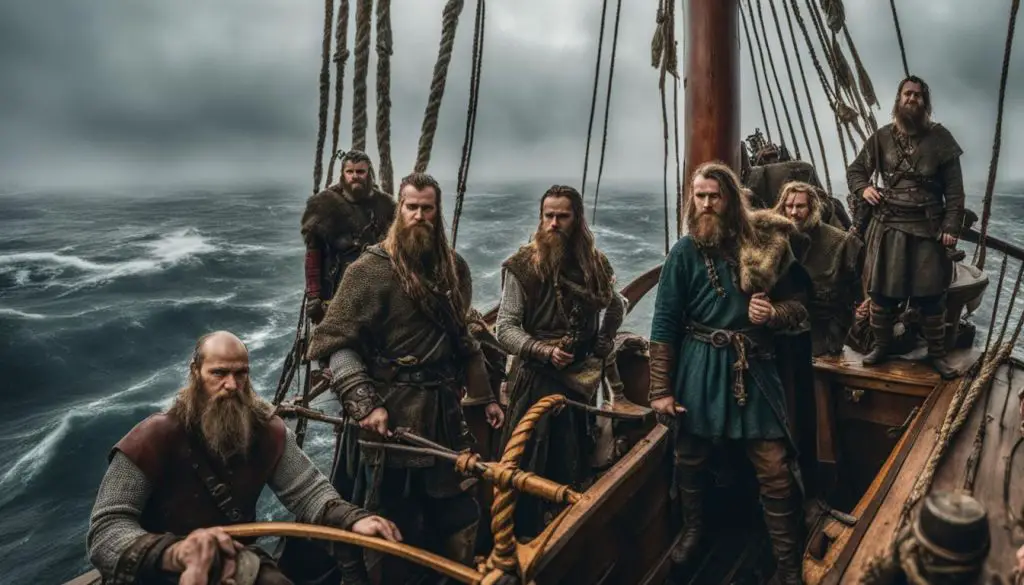
While the Vikings navigated without modern tools, their unwavering belief in luck and divine guidance propelled them forward, allowing them to conquer the open seas and explore new lands. The combination of their navigational skills, consultation with Völvas, and reliance on luck ensured that the Vikings became legendary seafarers and explorers, leaving an indelible mark on history.
The Controversy of the Viking Compass: Vegsvísir
The Vegsvísir is a symbol that has gained significant popularity in recent years as the “Viking Compass,” believed to aid travelers in avoiding getting lost during their journeys. However, there is a controversy surrounding its existence in the early medieval Viking period. While the Vegsvísir symbol is widely recognized today, its historical evidence is limited to an Icelandic manuscript written in the 19th century.
Historians and academics have raised skepticism regarding the authenticity of the Vegsvísir as a Viking symbol. Some argue that it was a later invention during the 19th century Viking revival, while others suggest that it might have been a symbol used in Icelandic folklore but not widely known or utilized by Vikings. The lack of concrete archaeological evidence further fuels the debate and leaves room for speculation.
“The Vegsvísir symbol is a fascinating topic of discussion among historians and Viking enthusiasts. While many see it as an important representation of Viking navigation and superstitions, others question its true historical significance.”
The controversy surrounding the Vegsvísir highlights the challenges historians face when interpreting Viking culture and determining the authenticity of symbols. It emphasizes the importance of critically evaluating historical sources and recognizing the potential influence of later interpretations and cultural revivals on our understanding of Viking beliefs and practices.
| Arguments | Evidence |
|---|---|
| The Vegsvísir was a genuine Viking symbol | Limited to an Icelandic manuscript from the 19th century |
| The Vegsvísir was a later invention during the 19th-century Viking revival | Lack of concrete archaeological evidence supporting its existence in the Viking era |
| The Vegsvísir might have been a symbol used in Icelandic folklore | Debate among historians and academics |
The Concept of Luck in Norse Culture
In Norse culture, luck was not simply seen as a matter of chance or random events. It was viewed as a personal quality that was inherent in individuals and their lineage. Luck was considered to be on par with other desirable characteristics such as strength or intelligence. It played a vital role in determining a person’s success, wealth, and power.
Luck was seen as something that was assigned by fate, rather than sought or found by coincidence. It was believed to shape events and circumstances to align with the desires and aspirations of the lucky individual. In this sense, luck was seen as a force that could be harnessed and influenced through personal qualities, actions, and even magical means.
The precise details of the Norse view on luck and its implications for society’s judgment of lucky and unlucky individuals are somewhat limited. However, it is clear that luck held great significance in Norse culture and was deeply intertwined with the belief in magic and the supernatural. It was a concept that shaped the way people understood their own lives and the world around them.
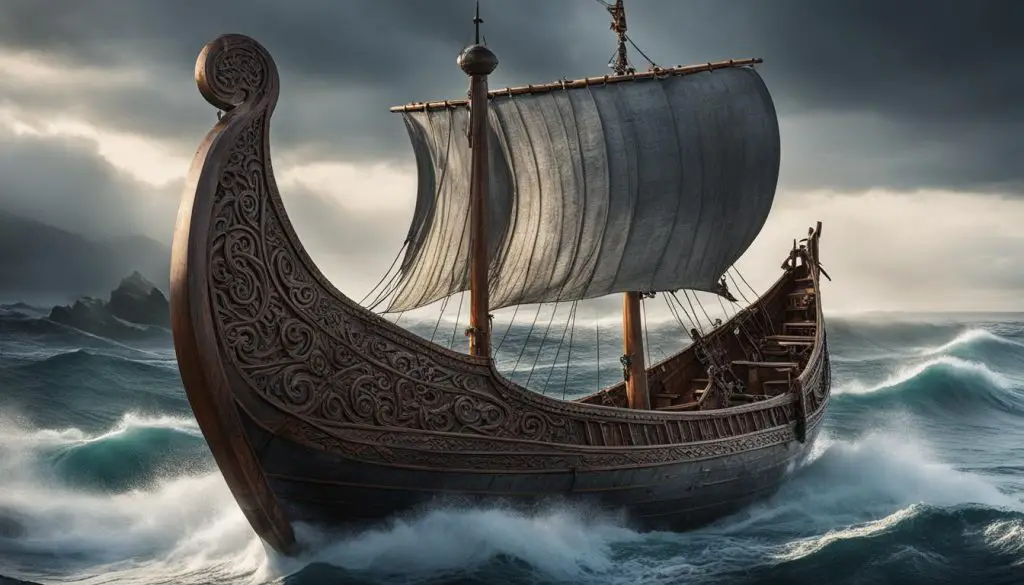
While luck may be commonly associated with chance or fortune in modern times, the Norse view of luck as a personal quality offers a unique perspective. It highlights the importance of individual agency and the belief that one’s own actions and qualities can shape their destiny. In Norse culture, luck was not merely a matter of chance, but an integral part of one’s identity and potential for success.
Odin’s Symbols and their Meanings
In Norse mythology, Odin, known as the Allfather, was a central figure associated with wisdom, magic, and power. He was revered by the Vikings and had several symbols that represented his various attributes and roles.
One of the most well-known symbols associated with Odin is the raven. The raven, which was believed to be Odin’s familiar and messenger, symbolized wisdom and knowledge. In Norse culture, ravens were considered birds of magical significance, often associated with foretelling the future and providing guidance on important matters.
Another symbol closely linked to Odin is Thor’s hammer, Mjölnir. Although primarily associated with Thor, Odin was believed to have created this powerful weapon. Mjölnir represented strength, protection, and the ability to harness lightning, making it a symbol of both physical and spiritual power.
“Ravens are known to be intelligent birds, and in Norse mythology, they are closely associated with Odin, the god of wisdom.”
Symbols of Protection and Guardianship
Odin was also associated with symbols of protection and guardianship. The Valknut, also known as Odin’s knot, was a symbol composed of three interlocking triangles. It was often associated with Odin’s role as a protector and defender. The Valknut symbol appeared on various Viking artifacts and was believed to invoke Odin’s protection in times of danger.
The Helm of Awe was another symbol associated with Odin’s protective nature. Shaped like a circle with intersecting lines extending outwards, the Helm of Awe was believed to create a shield of protection around the wearer and instill fear in their adversaries.
The Web of Wyrd, also known as “skuld’s net,” was a complex symbol associated with destiny and fate. It symbolized Odin’s constant pursuit of knowledge and wisdom, as well as his ability to manipulate and shape the outcome of events. The Web of Wyrd represented the interconnectedness of past, present, and future and how they are all intertwined in the grand tapestry of life.
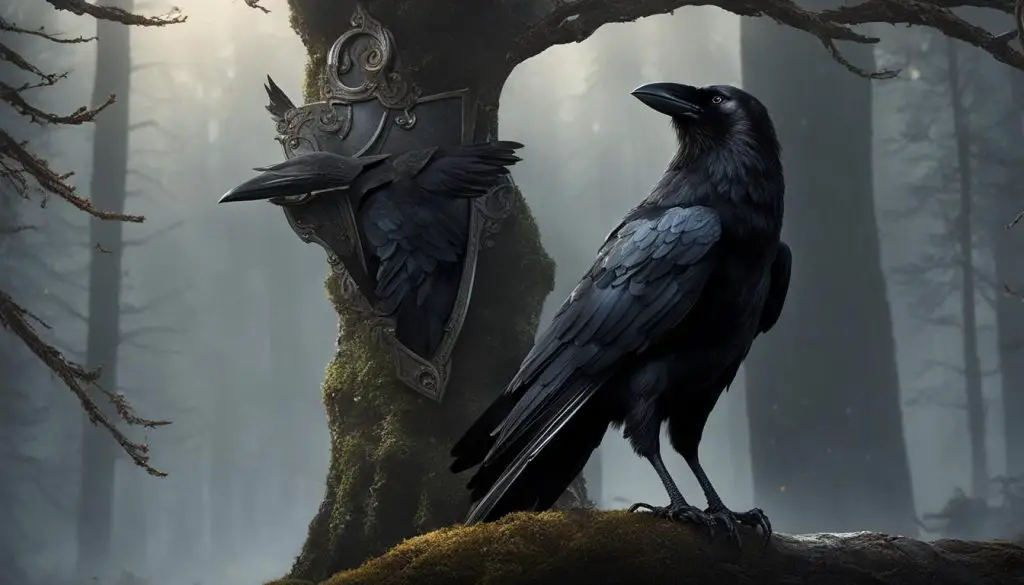
Table: Odin’s Symbols and Meanings
| Symbol | Meaning |
|---|---|
| Raven | Wisdom and knowledge |
| Mjölnir (Thor’s hammer) | Strength and protection |
| Valknut (Odin’s knot) | Protection and guardianship |
| Helm of Awe | Protection and intimidation |
| Web of Wyrd | Destiny and interconnectedness |
The Significance of Viking Symbols in Norse Culture
Viking symbols played a crucial role in Norse culture, conveying beliefs, stories, and values. They were used to communicate meaning, mark significant events, guide daily life, and connect the physical and spiritual realms. The intricate designs and deep meanings of Viking symbols speak to the creativity and ingenuity of the Vikings. Today, these symbols continue to impact interpretations of Viking heritage and are used in various forms of art and design.
Viking symbols served as a visual language that transcended the barriers of spoken communication. They were a means of expressing ideas, beliefs, and emotions in a society where literacy was limited. These symbols were not mere decorations but held powerful significance. For example, the Valknut, also known as Odin’s knot, symbolized the interconnectedness of life, death, and the afterlife. It represented the cycle of existence and was often associated with funerals and the guidance of souls to the realm of the dead.
The Helm of Awe
“I bear the helm of awe between my brows, the sign of defense and strength, to strike fear into my enemies and protect my people.” – Viking Warrior
The Helm of Awe, a symbol of protection and defense, was believed to grant its wearer strength and courage in battle. It was often worn by warriors as a talisman, invoking the power of the gods for victory and protection. The intricate pattern of the Helm of Awe was said to capture the energy and focus of a warrior, allowing them to enter battle with unwavering determination.
Conclusion
In conclusion, Viking culture was deeply intertwined with symbolism and belief in the power of magic. The Vikings used runes, skaldic poetry, and carved symbols on amulets to harness the magical properties they believed these objects possessed. While the existence of specific symbols like the Vegsvísir during the Viking era remains a subject of debate, there is no denying the significance of magic and symbolism in Viking societies.
These beliefs and practices provide us with a fascinating glimpse into the mindset and cultural heritage of the Vikings. Symbols were not just decorative but served as a means of communication, marking important events, and connecting the physical and spiritual realms. The intricate designs and deep meanings of Viking symbols continue to captivate our imagination and inspire modern interpretations of Viking culture.
Whether you are drawn to the wisdom symbolized by Odin’s ravens or fascinated by the concept of luck in Norse culture, the rich tapestry of Viking symbols and beliefs offers a world of exploration. Unlock the secrets of Viking culture through the lens of their symbols, and embark on a journey into the fascinating world of Viking mythology and folklore.
FAQ
Did Vikings believe in good luck charms?
Yes, Viking societies firmly believed in magic and the power of symbolism. They used runes, skaldic poetry, and amulets with carved symbols to harness the magical properties of these objects.
What was Norse magic and what role did it play in Viking societies?
Norse magic, known as seiðr, was closely associated with soothsaying and shaping the future. It was believed to be a powerful tool for the Vikings to see into the future and influence events. Norse gods like Odin and Freya were linked to magic and had the ability to see into the future.
Vikings were exceptional explorers and navigators. They relied on their knowledge of the stars, the sun, and the natural landmarks to guide their maritime journeys. They also believed in seeking guidance and protection from the gods during their travels.
What is the controversy surrounding the Viking compass, Vegsvísir?
While the Vegsvísir is often referred to as the Viking compass, its existence during the Viking era is debated among historians and academics. The popularity of the symbol gained traction during the 19th century Viking revival, but its historical evidence is limited.
How did Norse culture view luck?
In Norse culture, luck was seen as a personal quality inherent in individuals and their lineage. It was considered a vital aspect of success, wealth, and power. Luck was believed to be assigned by fate and shaped according to the wishes of the lucky individual.
What symbols are associated with Odin?
Odin, the Allfather of Norse mythology, is associated with several symbols. These include the raven, which was his familiar and messenger, Thor’s hammer, Mjölnir, which Odin was believed to have created, the Valknut, also known as Odin’s knot, and the Helm of Awe. The Web of Wyrd, or “skuld’s net,” is another symbol associated with Odin, representing destiny and fate.
What was the significance of Viking symbols in Norse culture?
Viking symbols played a crucial role in Norse culture, conveying beliefs, stories, and values. They were used to communicate meaning, mark significant events, guide daily life, and connect the physical and spiritual realms. The intricate designs and deep meanings of Viking symbols reflect the creativity and ingenuity of the Vikings.
What is the conclusion about Viking symbols and beliefs?
Viking symbols and beliefs highlight the importance of magic, symbolism, and superstition in Viking societies. While some specific symbols may be subject to debate, there is no doubt that magic and symbolism were integral to Viking culture. These beliefs continue to fascinate and inspire those interested in Viking heritage and mythology.

